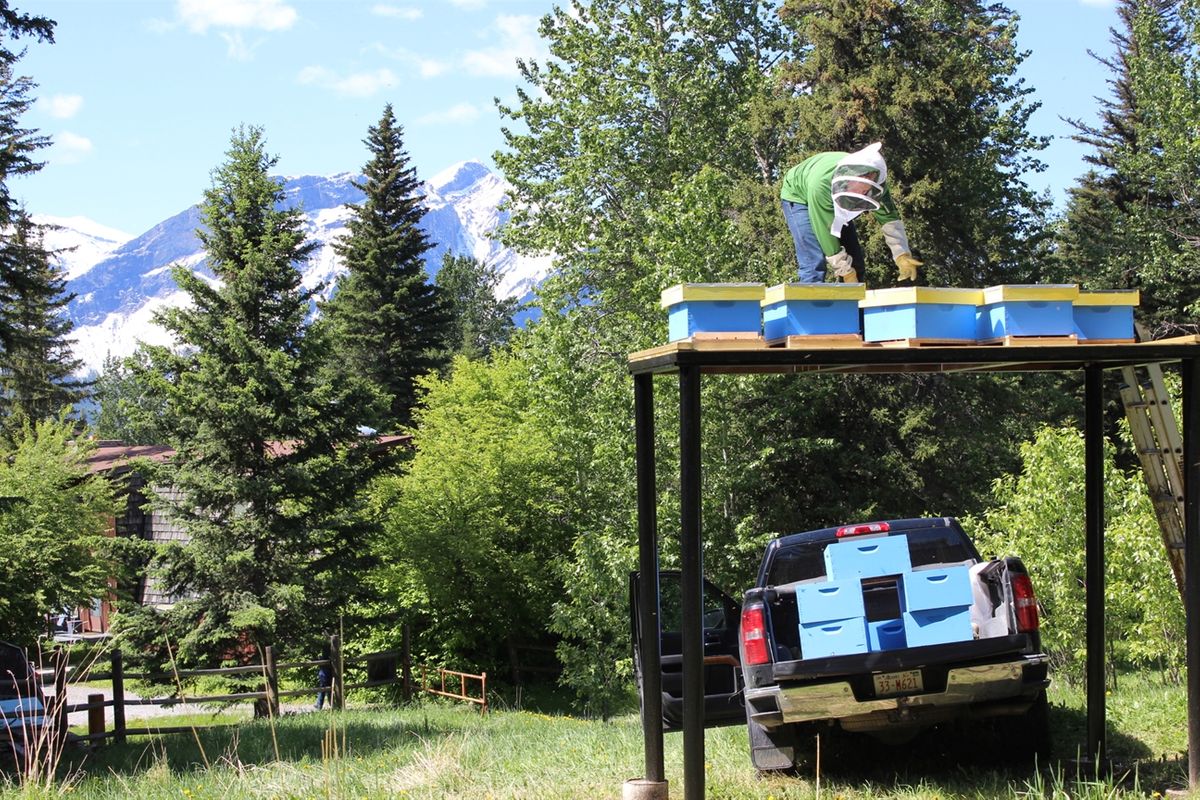WHY BEES AT THE OVERLANDER MOUNTAIN LODGE?
The main reason is to inform and educate our guests of the importance of bees. Since the early 2000s, the disappearance and declining number of bees has increased rapidly. Bees are not only essential for their honey but also for food production as they pollinate several crops. One third of food in the world is dependent on pollinating insects.
WHERE ARE THE BEES KEPT?
The bees are located approximately 500 meters from the hotel at our old horse stables. The location has signage for your convenience. We do advise to keep a safe distance from the hives, but please enjoy yourself by taking some photographs in the surrounding area.
HOW MANY BEES DO WE HAVE?
We have six hives, each hive has one queen and the others are a variety of drones and workers. At the start of the Spring season each hive has approximately 6,000 European honeybees. By the season’s end each will have over 36,000 bees, resulting in a grand total of 210,000 bees.
WHAT IS EACH BEE TYPE RESPONSIBLE FOR?
The Worker: A worker bee is any female bee that lacks the full reproductive capacity as the queen bee. Honeybee workers keep the hive temperature uniform in the critical brood area (where new bees are raised). Workers must maintain the hive's brood chamber at 34.4 °C to incubate the eggs. If it is too hot, they collect water and deposit it around the hive, then fan air through with their wings causing cooling by evaporation. If it is too cold, they cluster together to generate body heat. Worker bees gather pollen into pollen baskets on their back legs, to carry back to the hive where it is used as food for the developing brood. Nectar from flowering plants is sucked up through the worker’s proboscis, mixed with enzymes in the stomach, and carried back to the hive where it is stored in wax cells and evaporated into honey. Workers do everything but lay eggs and mate. They build the comb from wax extruded from glands under their abdomen, they clean, defend, and repair the hive. They feed the larva, the queen, and the drones, they gather nectar, pollen, water, and propolis (tree sap). They ventilate, cool and heat the hive. During their hunt for nectar and pollen, the pollen carried on the workers’ bodies may be carried to another flower where a small portion can rub off resulting in cross pollination. Almost all of civilization's food supply depends greatly on crop pollination
by honey bees.
The Drone: The drone is highly specialized to perform one function, mating with the queen. Once a drone has mated, they die. Drones are characterized by
eyes that are twice the size of those of worker and queen bees and a body size greater than that of worker bees, but typically smaller than the queen bee. The life expectancy of a drone is about 90 days. A colony begins to rear drones in spring and the drone population reaches its peak in late spring and early summer, all drones are driven out of the hive in the autumn. Drones will buzz around intruders in an attempt to disorient them if the hive is disturbed but have no ability to sting.
The Queen: The queen’s sole function is to serve as the reproducer. The queen’s abdomen is noticeably longer than the worker bees but in a hive of 36,000 honeybees, it is often difficult to find the queen. A queen can lay about 2,000 eggs per day during the spring, more than her own bodyweight in eggs every day. She is continuously surrounded by worker bees who meet her every need, giving her food and disposing of her waste. The queen lays a fertilized (female) or unfertilized (male) egg according to the width of the honeycomb cell. Smaller cells raise worker bees while drones are raised in cells that are significantly larger. To prevent a new queen bee from being born the acting queen bee sends out a pheromone that inhibits the worker bees from preparing a specialized cell from which a new queen could hatch. If a queen suddenly dies, the workers will flood several cells where a larva has just emerged with royal jelly. The young larva floats on the royal jelly while the worker bees then build a larger queen cell from the normal sized worker celland it protrudes vertically from the face of the brood comb.
WHERE DID THE BEES COME FROM AND ARE THEY HARMFUL?
Our hives are supplied by “Greidanus Honeymill” who are based out of High River Alberta. They have been beekeeping for over 50 years and have over 5000 bee hives. Of course the worker bees can sting but it is highly unlikely. The domestic honey bees are the most docile of all bees. Honeybees generally only attack when their hive is in danger, in this case please keep a safe distance from the hives themselves.
HOW MUCH HONEY WILL YOU PRODUCE AND WHAT WILL YOU DO WITH IT?
Each hive will produce approximately 110lbs-180lbs of honey depending on the season and weather conditions. Our culinary staff at the Stone Peak Restaurant will be maintaining the hives, extracting the honey and using the honey in the dining menu and in cocktails where appropriate. The general store at the Jasper East Cabins will also have this honey for purchase. $1 from every jar of honey sold will be used to plant native wild flowers that are beneficial to the pollinators and other species in our area.

